Papers by Victorio Sonzogni
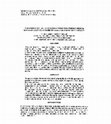
The analysis of plane frames with elements of great rigidity for tall buildings requires, in gene... more The analysis of plane frames with elements of great rigidity for tall buildings requires, in general, to take into account some factors which are usually disregarded when computing the element matrices. In this work, a computer code for the static and dynamic analysis of the building response is described. The model is based on Timoshenko beam, including axial, flexural and shear deformations, with a consistent mass matrix including the effects of rotational inertia of the cross section. Rigid portions, as well as hinges, may be included at the element ends. The element is able to model frame structures uncluding shear walls. The code provides a user friendly interface and may be used for eduactional purposes allowing to include new capabilities.The influence of factors affecting the response of frames with shear walls in static and dynamic response, as well as in free vibrations, is discussed. Results with finer finite element models are used for comparison purposes.
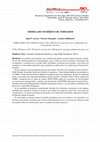
Los tornados son fenomenos muy violentos que pueden ocasionar danos materiales y perdidas de vida... more Los tornados son fenomenos muy violentos que pueden ocasionar danos materiales y perdidas de vida. Pueden producirse en determinadas zonas y tienen un efecto localizado y devastador. Por su naturaleza y ocurrencia no es sencillo medir velocidades y presiones de los mismos. A los efectos de estudiarlos se suele utilizar dispositivos que reproducen en laboratorios las condiciones de formacion de tornados. En este trabajo se trata el modelado numerico de tornados. Para ello se ha utilizado el software PETSc-FEM (Portable, Extensible Toolkit for Scientific Computation - Finite Element Method), desarrollado en el CIMEC (Centro Internacional de Metodos Computacionales para Ingenieria), basado en elementos finitos y que utiliza procesamiento distribuido (calculo paralelo), corriendo sobre el cluster Aquiles del CIMEC, compuesto por 82 nodos de calculo. PETSc-FEM modela las ecuaciones de Navier-Stokes no estacionarias incompresibles, mediante una formulacion SUPG/PSPG (Streamline-Upwind Pet...
Resumen: En varias ocasiones, tormentas que se desarrollaron sobre la región central de la Repúbl... more Resumen: En varias ocasiones, tormentas que se desarrollaron sobre la región central de la República Argentina han producido daños de variada magnitud en estructuras livianas, particularmente galpones y silos. La magnitud de los daños va desde el arrancamiento de algunas chapas de la cubierta hasta la destrucción total de las mismas. Por lo general estas tormentas afectan áreas bastante extensas, del orden de cientos de kilómetros de extensión, dependiendo del sistema meteorológico que provocó las tormentas. En algunos casos los daños han llegado a la destrucción de la casi totalidad de las construcciones de estos tipos en una o varias localidades, con cuantiosas pérdidas materiales e incluso pérdidas de vidas humanas. En este trabajo se analizan algunas causas de daños observados a consecuencia de una tormenta particularmente significativa.
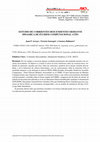
En este trabajo se muestran algunos resultados preliminares del modelado numerico de corrientes d... more En este trabajo se muestran algunos resultados preliminares del modelado numerico de corrientes descendentes. El objetivo es evaluar el efecto de estos fenomenos sobre las construcciones, midiendo las presiones causadas por estos sobre las estructuras, producto de la misma corriente descendente, y de la formacion de vortices horizontales, con sus consecuencias sobre la estructura. Para el modelado numerico se ha utilizado el software PETSc-FEM (Portable, Extensible Toolkit for Scientific Computation - Finite Element Method), desarrollado en el CIMEC (Centro Internacional de Metodos Computacionales para Ingenieria), basado en elementos finitos y que utiliza procesamiento distribuido (calculo paralelo), corriendo sobre el cluster Aquiles del CIMEC, compuesto por 82 nodos de calculo. El metodo de discretizacion utilizado es el de los Elementos Finitos Estabilizados mediante la formulacion SUPG/PSPG (Streamline-Upwind Petrov-Galerkin / Pressure Stabilizing Petrov-Galerkin) para las ecua...
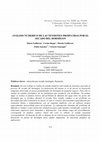
Resumen. En este trabajo se realiza un estudio numérico del estado de tensiones asociado al proce... more Resumen. En este trabajo se realiza un estudio numérico del estado de tensiones asociado al proceso de secado del hormigón. La motivación del mismo es el de prever la fisuración temprana observada en piezas premoldeadas de hormigón de pequeño espesor. Para ello se realiza un estudio sistemático de los fenómenos que producen este problema.. En primer lugar se realiza el planteo teórico del problema de difusión del agua entre los poros del hormigón que se produce durante el secado. Este estudio conduce a un problema en derivadas parciales transitorio no lineal, el cual se resuelve discretizando espacialmente por elementos finitos y temporalmente con un esquema implícito, con un software propio especialmente desarrollado para tal propósito. La información obtenida del problema de difusión se traduce a una retracción volumétrica para cada instante considerado, a partir de relaciones empíricas entre humedad y deformación. Una última etapa del procedimiento corresponde al análisis estático lineal del cual se obtiene el estado tensional correspondiente. En función de ello se dispone de un criterio para evaluar la posibilidad de fisuración en piezas de hormigón para edades tempranas. Se muestran ejemplos de aplicación..
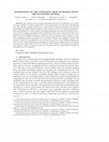
The Composite Finite Element Mesh method is useful for discretization error estimation and, in ad... more The Composite Finite Element Mesh method is useful for discretization error estimation and, in addition, for solution improvement with no appreciable increment in the computational cost. The technique consists in redefine over a given mesh the linear operator that arises from the discretization of a partial differential equation. This operator is modified according to an appropriate linear combination between the operators of the given mesh and of a coarse mesh, which must be a coarsening of the first one. On the other hand, Multigrid methods solve a linear system using systems of several sizes resulting from different discretization levels. This feature motivates the study of the application of the Multigrid strategy in conjunction with the Composite Mesh technique. In this work, we propose a scheme for solving the linear system arising from the Composite Mesh strategy using a Multigrid method. Particularly, we use a geometric version of the Multigrid technique. The proposal is based on...

The composite finite element mesh method is useful for discretization error estimation and, in add... more The composite finite element mesh method is useful for discretization error estimation and, in addition, for solution improvement with no increment in the computational cost. The technique consists in redefine over a given mesh the linear operator that arises from the discretization of a partial differential equation. This operator is modified according to an appropriate linear combination between the operators of the given mesh and of a coarse mesh, which must be a coarsening of the first one. In this work a novel algebraic composite mesh technique is proposed. The technique uses some tools from the Algebraic Multigrid method for the definition of the coarse mesh and the discrete space associated with it. Mesh coarsening is based on the fusion of elements in macroelements, with a new definition of the grid topology and basis functions. The agglomeration of elements is made in order to reduce the mesh anisotropy, which is of importance in the discretization of convection-diffusion-reaction ...
Revista Internacional de Métodos Numéricos para Cálculo y Diseño en Ingeniería, 2012
aisladas, sin cerramiento lateral. Esta tipología es muy común en regiones rurales y urbanas de A... more aisladas, sin cerramiento lateral. Esta tipología es muy común en regiones rurales y urbanas de Argentina, sea para estacionamientos, instalaciones educativas, deportivas, etc., y sin embargo, no aparece contemplada en los reglamentos para evaluación de la acción del viento en construcciones civiles. Para obtener los resultados numéricos se ha utilizado un programa de elementos finitos, desarrollado para un cluster de microprocesadores. También se han realizado estudios experimentales en el túnel de viento de capa límite de la Universidad Nacional del Nordeste para validar los resultados computacionales. Se ha podido conseguir una buena concordancia entre los resultados numéricos y experimentales. Se han obtenido resultados originales de coeficientes de presión para el tipo de cubierta en estudio.
Journal of Sound and Vibration, 1996
Journal of Sound and Vibration, 1992
An approximate analytical solution is obtained for the title problem by using a Naviertype soluti... more An approximate analytical solution is obtained for the title problem by using a Naviertype solution. It is shown that the fundamental frequency coefficient obtained by means of this procedure is in reasonably good agreement with the result obtained by using a finite element algorithmic methodology. Obviously the type of material disturbance considered introduces considerable change in the dynamic behavior of the structural element and this fact is clearly shown in the variation of the fundamental frequency value.
Journal of Sound and Vibration, 1990
Transverse vibrations of the structural system described in the title are analyzed by using class... more Transverse vibrations of the structural system described in the title are analyzed by using classical plate theory and employing two different methodologies: the recently developed ``optimized Kantorovich approach'' and a finite element algorithmic procedure. It is shown that the fundamental frequency coefficients obtained by using both techniques for a rather wide variation of the governing geometric parameters are in very good agreement. Lower frequency coefficients of the plate system determined by means of the finite element method are also presented.
Journal of Sound and Vibration, 1997
Journal of Sound and Vibration, 1998
Journal of Sound and Vibration, 1999
Journal of Applied Mechanics, 2006
A stabilized mixed finite element with elemental embedded strong discontinuities for shear band m... more A stabilized mixed finite element with elemental embedded strong discontinuities for shear band modeling is presented. The discrete constitutive model, representing the cohesive forces acting across the shear band, is derived from a rate-independent J2 plastic continuum material model with strain softening, by using a projection-type procedure determined by the Continuum-Strong Discontinuity Approach. The numerical examples emphasize the increase of the numerical solution accuracy obtained with the present strategy as compared with alternative procedures using linear triangles.
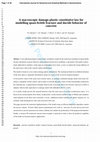
International Journal for Numerical and Analytical Methods in Geomechanics, 2011
SUMMARYA new phenomenological macroscopic constitutive model for the numerical simulation of quas... more SUMMARYA new phenomenological macroscopic constitutive model for the numerical simulation of quasi‐brittle fracture and ductile concrete behavior, under general triaxial stress conditions, is presented. The model is particularly addressed to simulate a wide range of confinement stress states, as also, to capture the strong influence of the mean stress value in the concrete failure mechanisms.The model is based on a two‐surface damage‐plastic formulation. The mechanical behavior in different domains of the stress space is separately described by means of a quasi‐brittle or ductile material response: (i) For positive values of the mean stress (tensile states), an isotropic continuum damage model with strain softening is considered. In this context, and in order to avoid the Boundary Value Problem ill‐posedness induced by the softening law, a regularization technique based on the Continuum Strong Discontinuity Approach (CSDA) is adopted, which results equivalent to a damage model with ...
Earthquake Engineering & Structural Dynamics, 1984
A reinforced concrete frame‐wall structure of a building designed in accordance to standard pract... more A reinforced concrete frame‐wall structure of a building designed in accordance to standard practice in Argentina was analysed by the procedures prescribed by current Argentine Codes. In addition, the inelastic step‐by‐step response of the structure to design spectrum‐compatible accelerograms was studied by means of a special element for inelastic dynamic analysis of reinforced concrete frames. Results obtained by the different methods of analysis are presented.
Applied Acoustics, 1996
The problem described is solved by approximating the displacement function using simple polynomia... more The problem described is solved by approximating the displacement function using simple polynomial coordinate functions which identically satisfy the boundary conditions. The numerical determinations of the eigenvalues under investigation are determined using the RayleighRitz method assuming that the plate thickness varies according to the functional relation h(r) = h,[l + r(r/a)"], w h ere n is an integer. It is shown that the frequency coeficients and critical bukling load parameters obtained by means of the analytical procedure are in excellent agreement with the results obtained employing a finite element algorithmic procedure. It is concluded that the value of Poisson's ratio has a significant effect upon the frequency and buckling parameters, especially in the case of plates of nonuniform thickness and with simply supported edges.








Uploads
Papers by Victorio Sonzogni